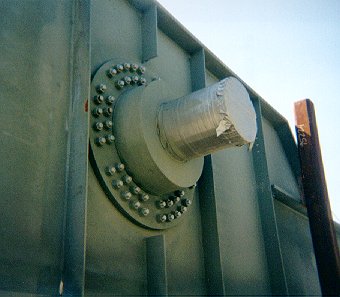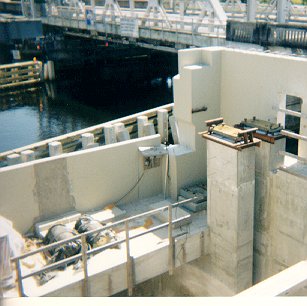DESIGN OF TRUNNION-HUB GIRDER ASSEMBLIES FOR BASCULE BRIDGES
Committed to bringing numerical methods to undergraduates

Home | Grant 1: (98-01) | Grant 2: (01-03) | Grant 3: (04-05) | Pictures | Links
|
DESIGN OF TRUNNION-HUB GIRDER ASSEMBLIES FOR BASCULE BRIDGES Committed to bringing numerical methods to undergraduates |
|
|
|
|
||
|
Home | Grant 1: (98-01) | Grant 2: (01-03) | Grant 3: (04-05) | Pictures | Links |
||
Background | Grant | Technical Papers Grant 2: Hub-girder bolt assembly without an interference fit in bascule bridges |

To
address this issue, the FDOT instituted a combined analytical and
experimental study in 1998. The
analytical part (Phase I) of this study used a finite element program
that determines transient temperatures and stresses, critical stresses
and critical crack lengths in the THG assembly.
These parameters were mainly studied for first finding whether
the critical stresses exceeded the yield strengths or allowable
stresses of the materials used for the THG assembly.
Also, since there were two different assembly procedures that
could be used to develop the final THG assembly, the critical stresses
and critical crack lengths were compared to find the optimum assembly
procedure. This finite
element program has an interactive graphical user interface, in which
a range of parameters can be defined and altered, and hence, can be
used for thermal stress and fracture resistance analysis on any future
THG assembly built in Florida or the rest of the country. The experimental part (Phase II) of the previously study was done to confirm the finite element results and also develop specifications for the assembly procedure, which previously had been not available. This part of the study involved instrumenting a full-scale trunnion, hub, and girder, and recording temperature and stress at various locations throughout both assembly procedures. This phase was completed during Summer 2001 and clearly validates all of the results from Phase I. The
results from Phases I and II of the aforementioned research to study
the trunnion-hub-girder assemblies of bascule bridges indicate that a
serious problem can arise during one of the assembly procedures of the
THG. The problem, a high
probability of cracks developing in the hub (and possible catastrophic
failure), exists when a trunnion-hub assembly is cooled in liquid
nitrogen for shrink-fitting into the girder during one of the assembly
procedures; namely, when the trunnion is shrink fitted into the hub
and then the trunnion-hub assembly is shrink fitted into the girder. REQUESTED SERVICES:
|
| | Mechanical | USF | FDOT | E-mail |
 |